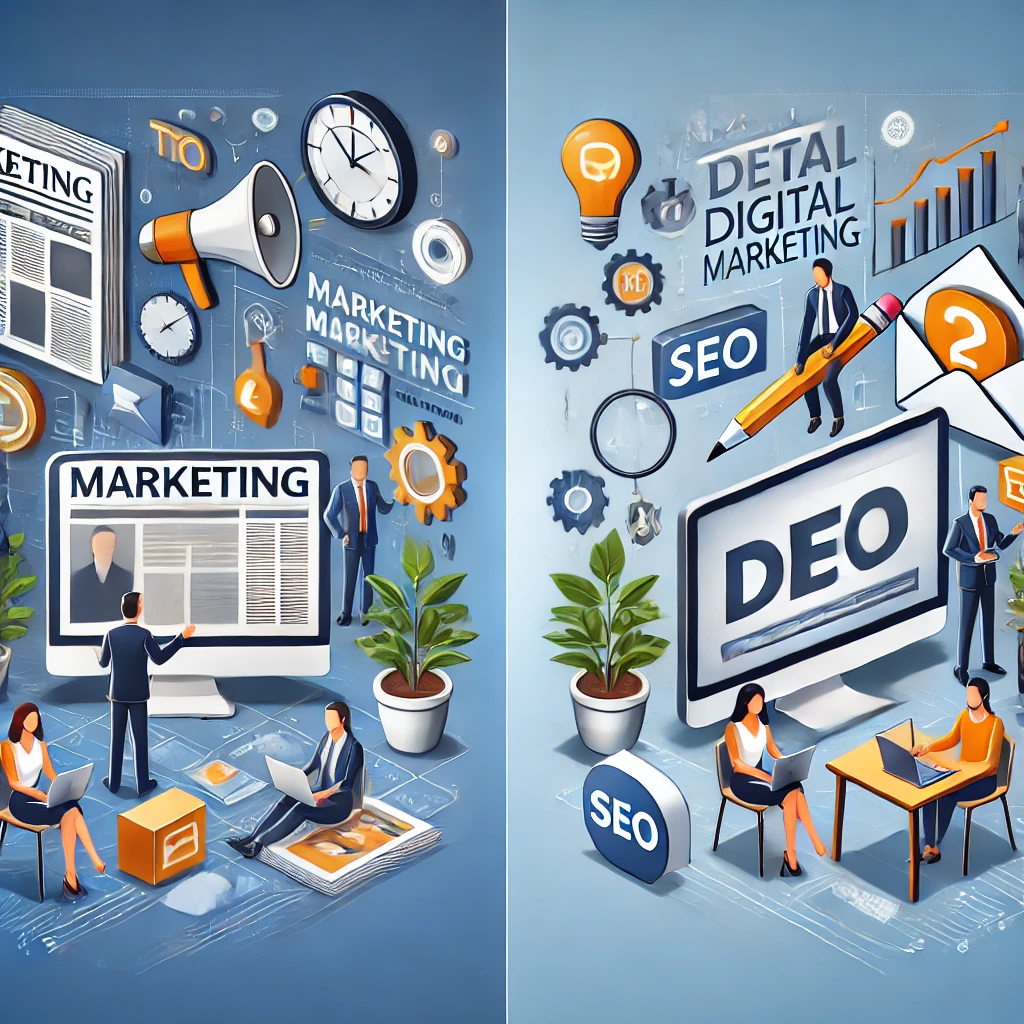10 Key Differences Between Traditional vs Digital Marketing (2024 Guide)
Marketing is an essential tool for businesses aiming to promote products and services. However, deciding between traditional and digital marketing can be challenging, especially with both having unique advantages. In this guide, we’ll explore 10 key differences between traditional vs digital marketing, helping you identify which is better suited to your business goals in 2024.
What is Traditional Marketing?
Traditional marketing refers to offline marketing strategies used before the digital age. These include channels like TV, radio, newspapers, magazines, billboards, direct mail, and telemarketing. Traditional marketing has been around for decades, making it a tried-and-true method that many still trust.
Characteristics of Traditional Marketing:
- Non-digital mediums like print, radio, and TV ads.
- Focuses on reaching broad, mass-market audiences.
- Relies on tangible forms of advertising, such as flyers, brochures, and posters.
Explore more about traditional marketing tactics here
What is Digital Marketing?
Digital marketing, on the other hand, involves the use of online platforms to promote products and services. Popular digital marketing methods include social media marketing, email marketing, content marketing, SEO (Search Engine Optimization), PPC (Pay-Per-Click) advertising, and influencer marketing.
Characteristics of Digital Marketing:
- Operates through digital channels like social media, websites, and email.
- Targets highly specific audiences through data-driven techniques.
- Allows for personalized communication and interaction with customers in real-time.
Read more about digital marketing strategies here
10 Key Differences Between Traditional and Digital Marketing
1. Audience Reach
- Traditional Marketing: Primarily reaches local or regional audiences, depending on the medium used (TV, radio, print).
- Digital Marketing: Can reach global audiences instantly with the click of a button.
2. Cost Efficiency
- Traditional Marketing: Often more expensive, especially for TV commercials or large print ads.
- Digital Marketing: Cost-effective, with opportunities for even small businesses to promote themselves through affordable channels like social media.
3. Measurability
- Traditional Marketing: Difficult to measure exact results, often based on estimates (e.g., audience ratings for TV ads).
- Digital Marketing: Provides detailed analytics on campaign performance, such as clicks, impressions, and conversion rates.
4. Targeting Capabilities
- Traditional Marketing: Broad targeting, often using demographic data based on TV viewership or magazine readership.
- Digital Marketing: Hyper-targeted strategies using online data, such as geographic location, interests, and browsing behavior.
5. Interactivity
- Traditional Marketing: One-way communication (e.g., TV ads convey a message but don’t invite direct interaction).
- Digital Marketing: Two-way communication, allowing businesses to engage with customers via comments, social media, or live chat.
6. Speed of Results
- Traditional Marketing: Results can take time to materialize, as campaigns are not always immediately trackable.
- Digital Marketing: Instant feedback, allowing marketers to measure the success of a campaign in real-time and make quick adjustments.
7. Longevity
- Traditional Marketing: Can last longer in people’s minds due to the physical nature of ads (e.g., billboards, flyers).
- Digital Marketing: Shorter lifespan for most online ads, but content like blog posts and videos can provide ongoing value.
8. Engagement Strategies
- Traditional Marketing: Mostly passive; customers see or hear the message but cannot directly respond.
- Digital Marketing: Active engagement through likes, shares, comments, and direct interaction on platforms like Instagram or Facebook.
9. Content Customization
- Traditional Marketing: Limited customization; a single ad typically serves a broad audience.
- Digital Marketing: Allows for personalized content tailored to the specific interests and behaviors of individual users.
10. Conversion Rate Optimization
- Traditional Marketing: Conversion tracking is challenging, with vague methods like coupon codes or foot traffic surveys.
- Digital Marketing: Allows direct conversion tracking via tools like Google Analytics, showing the exact path users take from ad to sale.
Conclusion: Choosing the Right Strategy
When comparing traditional vs digital marketing, it’s clear that both have their pros and cons. Traditional marketing is effective for reaching older, less tech-savvy audiences and offers a certain level of trust and credibility. On the other hand, digital marketing is ideal for businesses looking to engage with younger, tech-savvy consumers, offering precise targeting and measurable results.
Ultimately, the right strategy depends on your business goals, target audience, and budget. For maximum effectiveness in 2024, many businesses may opt for a hybrid approach, combining the strengths of both traditional and digital marketing.
